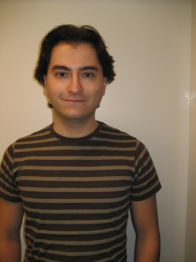Hydrogen storage materials: A first-principles study
Promotion date: 29. October 2009
Promotor: Prof. Dr. Paul Kelly
Assistant Promotor: Dr. Geert Brocks
| Scenarios to launch hydrogen as an important energy carrier are only realistic if hydrogen can be stored in a light, compact, fast and reliable way, under moderate conditions. Using materials that absorb hydrogen is one route that can lead to this goal. Initially, storage materials are considered that store hydrogen in atomic form. The focus is on the bulk properties of magnesium-dihydride (MgH2) and its alloys with lightweight transition metals (TM) and aluminium or silicon. TM-alloying initiates a phase transition that results in a significant enhancement of (de)hydrogenation kinetics. Adding aluminium or silicon to Mg-Ti greatly improves the thermodynamic properties. Alternatively, materials are considered that store hydrogen in molecular form, which leads to fast kinetics. Polylithiated carbon and oxygen molecules show promising hydrogen storage properties, both in the gas and in the condensed phases. Planar boron sheets decorated with alkali metals have very promising storage properties as well. |
Studying hydrogen is a present-day topic ...
Yes, very much so. The Netherlands is playing a major international role in this. My project was part of the Advanced Chemical Technologies for Sustainability (ACTS) programme, supported by NWO and energy companies like Shell and Nuon.
My contribution was to model some of the most promising bulk hydrogen storage materials, in accordance with the lab experiments performed in the Netherlands. A fundamental approach is needed to investigate the physical and the chemical properties of completely new storage systems.
Computation of the crystal structure change of MgH2 upon TM alloying, for example, leads to new kinetic insights. Moreover, adding aluminium or silicon to Ti-doped MgH2, greatly improves the thermodynamic properties, and consequently makes it more suitable for practical applications.
These theoretical findings have guided experiments in a certain direction already, and will do so even more in the future, I expect.
How did you come into contact with the Computational Materials Science group?
Originally, I was trained as a quantum chemist at Bilkent University in Turkey. I applied to a few leading universities in Europe and in the United States.
At first, I didn’t know so much about University of Twente. After meeting the people working here, I was impressed from the start. Here, research takes place in an open environment, most doors are open and you can discuss your work in a personal way, no matter the hierarchical position.
Also, I benefited very much from the flexibility of the working environment and the research topic. Moreover, there was always room for creativity, and some bright ideas have successfully turned into feasible sub-projects, such as the ones that form the second part of my thesis.
What do you consider your main achievement?
I started the thesis project with the ambition to make good publications, which worked out very nicely, especially the publications in the American Physical Society and the American Chemical Society. This was very encouraging, of course.
As a researcher I enjoyed the second part of my project the most, creating my own idea, get it implemented and being able to work it out, purely by using supercomputers to perform the massive calculations.
My work is appreciated at many instances by poster presentations, talks and publications, and also put into action by the experimental scientists.
What are your future plans?
In the short term, I would like to stay in research, possibly in an English speaking country that is at the forefront of science, but favourably in the Netherlands. As a result-minded person that would be very profitable for me, because I already know the way how things work over here, and what is needed to obtain good results.
After developing some extra skills, perhaps one day I will start my own little company. I am going to work out on a business plan, that involves secure software applications for developing technologies.

